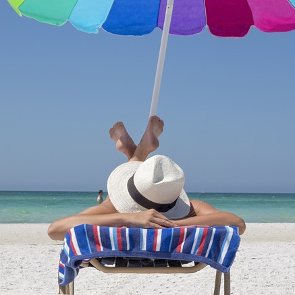6 Tips for Relieving Sunburn
 We all know that overexposure to ultraviolet radiation (in other words, the sun) is bad for skin and that prevention is better than the cure, but sunburns still are a common occurrence. Here are six tips for relieving sunburn.
We all know that overexposure to ultraviolet radiation (in other words, the sun) is bad for skin and that prevention is better than the cure, but sunburns still are a common occurrence. Here are six tips for relieving sunburn.Sunburn is the most common type of radiation burn. Typical symptoms include red or reddish skin that is hot to the touch, swelling, peeling skin, pain, mild dizziness, nausea, chills, and fever. Extreme sunburns require hospital care, but minor sunburns can be treated at home. Here are the ways to soothe sunburned skin, reduce pain, and facilitate healing.
Get Out of the Sun
This may seem like a no-brainer, but sometimes people get carried away and forget to use their common sense. To prevent blisters and ending up in the ER, get out of the sun as soon as your skin turns red and starts feeling hot or/and itchy.
Take a Cool Shower or Bath
Sunburned skin usually feels hot to the touch because of the increased blood flow to the affected area. A lukewarm shower or bath will provide instant (although temporary) relief. To avoid irritating your skin further, follow these simple rules:
- If showering, make sure that the water pressure is low.
- Avoid using shower gels, soap, or other detergents.
- Don’t rub your skin with a towel. Instead, pat your skin gently or let it air dry.
If you can’t take a bath or shower right away, apply a cold, wet compress to the affected area for about half an hour.
Use a Pain Reliever
To soothe pain, you can take an over-the-counter pain reliever such as ibuprofen or aspirin, or apply a topical pain reliever. Topical pain relievers are sprays that have a numbing effect due to containing benzocaine or lidocaine. However, pain reliever sprays may cause an allergic reaction, so use them only if you’re are 100% sure that you’re not allergic or hypersensitive to substances that end with “-aine”.
Hydrate
Your body loses fluids when you get sunburned so be sure to stay hydrated both inside and out. Drink plenty of water and use a moisturizer that will soothe your skin and replenish moisture. For a maximum effect, use a special after tanning lotion or aloe vera gel. Consider putting your moisturizer in the fridge before applying it since cold lotion will feel great on hot skin. Reapply moisturizer as often as you need.
Protect the Skin While It Heals
If you want your skin to heal faster, make sure to protect it from further sun exposure. If you cannot avoid being outdoors, wear loose clothes that cover your skin, apply sunscreen to your face, and wear a hat and sunglasses to protect your scalp and eyes. Protecting your skin also means keeping your hands off it. Don’t peel burned skin or pop blisters if you want your skin to heal quickly without any scars left.
Seek Medical Help If Necessary
Contact a doctor immediately if you experience one of the following signs or symptoms:
- Weakness, extreme fatigue, confusion, dizziness
- Pain or headache that doesn’t respond to over-the-counter painkillers
- Nausea, chills, fever, or rash
- Increased redness, swelling, warmth or pain in the affected area
- Swollen lymph nodes
You should seek medical attention for second-degree sunburns (blistered skin) because blisters get infected easily. While waiting for an appointment with a doctor, avoid rubbing, scraping and popping the blisters.
Breadcrumbs
Tags
Related Articles
- Types of Headache, Homemade Banana Face Masks, How to Boost Your Child's Immune System, 6 Tips to Shrink Your Pores